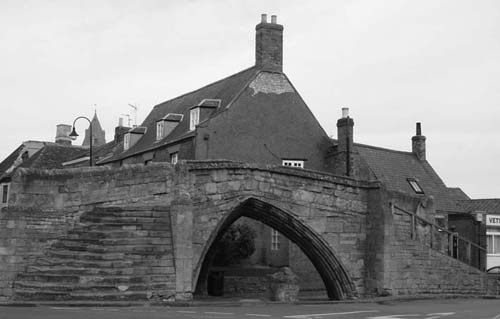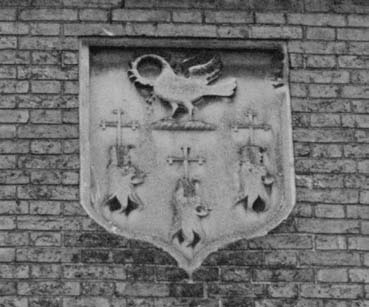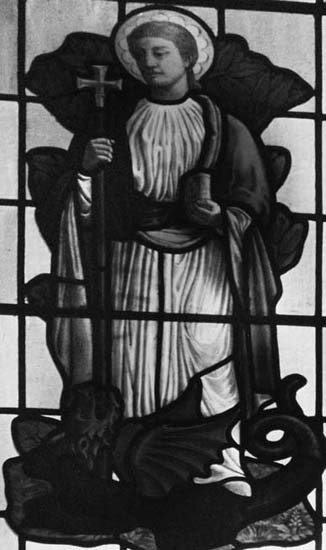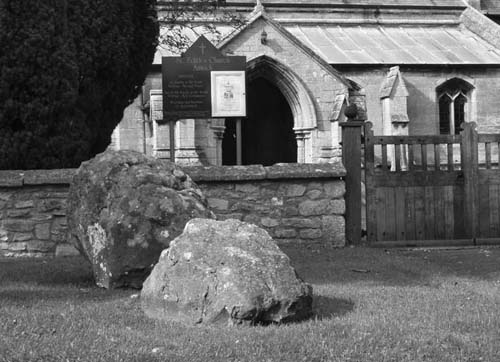Folklore of Lincolnshire (5 page)
Read Folklore of Lincolnshire Online
Authors: Susanna O'Neill


The ruins of Crowland Abbey, Peterborough, with the parish church fully intact behind.
Thoughout history, the Devil seems to know when there are any actions being performed that display human weakness. His evil radar is alerted and he swoops in to help continue the chaos and corruption. One example of this in Lincolnshire was around 869 at the Benedictine abbey at Crowland. The legend goes that the monks had fallen into sinful ways, drinking heavily and behaving in a manner unbefitting their order. It was rumoured that one monk had even sold his soul to Satan, for the secret of everlasting life. One day, after months of dreadful behaviour, there was a terrible rumbling of thunder which shook the very walls of the monastery.
A terrifying black cloud grew around the building from which a great figure could be seen to emerge. ‘It was Satan himself … so fearful in countenance, so diabolical in its malignity that all fell cowering before the vision.’
15

Trinity Bridge, Crowland, is another ancient monument worth a look whilst in the town. The wooden version of the structure was first mentioned in a charter of King Edred in 943, and the present stone bridge dates from the fourteenth century. It is an amazing structure, reminding us of the great changes to the surrounding landscape, as there is no water to be seen now. An interesting statue resides there, thought to be either Christ or King Ethelbald.
It seems that he had been sent to them by God, who was so appalled at their behaviour that he had left them in the Devil’s hands. He told them they were cursed and that within twelve months the abbey would be in ruins. The monks were terrified that they would be damned for all eternity and vowed to be more reverent, but as the months passed and the horror of that night faded from their memories, they began to slip back into their old ways.
Then one day the monk on lookout saw something in the distance that made the memory come back with full force. He relayed the news to the others and eventually they could all make out the fleet of Viking longboats approaching. The monks fled to the chapel and prayed for deliverance but each could hear the Devil’s knowing laugh reverberating through their heads.
The Vikings were merciless and slaughtered as many of the monks as they could find, ransacking the abbey and pillaging whatever they could lay their hands on. There was nothing left when they had finished, just as the Devil had predicted, save for a pile of corpses that they set fire to.
Often when talking of the Devil, dragons are included in the stories. Dragons are age-old mythological creatures that predate any history we have. Whether legend or
fact, they have populated stories in every culture throughout time. China uses the symbol of the dragon in much of its mythology as representing strength and power, whereas in western culture dragons are viewed as evil creatures, often connected to the Devil – apart from Wales, which is proud of its dragon connections.

A depiction of the King’s Lynn coat of arms.
And war broke out in heaven. Michael and his angels fought against the dragon. The dragon and his angels fought back, but they were defeated, and there was no longer any place for them in heaven. The great dragon was thrown down, that ancient serpent, who is called the Devil and Satan, the deceiver of the whole world – he was thrown down to the earth, and his angels were thrown down with him.
16
The arms of King’s Lynn, Norfolk, depict a dragon’s head pierced by a cross. The legend behind this involves St Margaret of Antioch, a noble virgin-martyr whom the Devil devoured whilst in the form of a dragon, but the faithful child always wore a cross around her neck and by its power she was able to burst the dragon open and escape, unhurt.
Treasure is also factored into many local dragon tales, such as the two serpents that guard Cissbury Ring, an Iron Age hill fort, where a wealth of gold and gems is supposedly buried. Also the legend that a flying dragon may still pass overhead between Devon’s Dolbury Hill and Cadbury Hill, guarding each location where it hid riches, and the story of a worm which abides at Gunnarton Castle, also known as Money Hill due to the legends of treasure in the area.
Turning our attention back to Lincolnshire, there are two boulders of Spilsby sandstone which sit outside the south gateway of St Edith’s Church, known as the Drake Stone. Some folklorists believe ‘drake’ to be a corruption of ‘dragon’. The Drake Stone, always referred to in the singular, has various stories attached to it, including variations as to why it is named thus.
Folklorist Ethel Rudkin quotes from one traditional account of the stones that she found which referred to them as the ‘Duck and Drake Stones’.
17
She goes on
to explain that Duckstone was a popular Lincolnshire game at the end of the nineteenth century, which may have given name to these stones, but she thinks actually that Drake is being used in the same sense as the expression ‘fire drake’.
In Germanic mythology a fire drake was a fire-breathing dragon with a reptilian body and sometimes also with wings. In these German and also Celtic myths the fire drake often lived in caves and guarded some great treasure.
The story here runs that a local man was ploughing his field, which was known as ‘Drake Stone Close’, when suddenly his horses and plough started disappearing into what seemed like quicksand. He tried with all his might to wrench his horses out of danger, whilst keeping himself on firm ground, but they were steadily sucked under until they disappeared completely. Then, startling the poor man even more, a creature suddenly flew out of the hole and rose into the sky, quacking!
This is where the story breaks into two camps. One camp claims it was a drake which flew from the hole, the other of course asserts it was a dragon which flew from the hole, where lay the treasure that it had been guarding.

A stained-glass window at St Margaret’s Church, King’s Lynn, showing St Margaret of Antioch defeating the dragon.
Rudkin declares that the farmer returned to the site of the incident the very next day, but the ground was completely firm. There was, however, a large boulder on the
spot, which resembled something like a drake’s head, hence the name Drake Stone. Again, we are unsure as to whether this was the bird or a dragon and as the stone has broken into two pieces, it is difficult now to see any shape resembling either. The latter seems perhaps more convincing, especially as the village of Dragonby, near Scunthorpe, is named after a natural outcrop of rock which looks like a dragon.

The Drake Stone’s final resting place, outside St Edith’s Church, Anwick.
Naturally, after this event many people tried their hand at retrieving the treasure buried beneath the stone, though none were successful. One man, it is said, chose some particularly strong oxen to help move the boulder, to which he fastened great chains, but even though they pulled with all their might they only managed to move it an inch before the chains broke and the oxen collapsed, exhausted. Then the drake or dragon made another appearance – flying out from under the stone, surveying the scene and then returning to its guardian position.
After that it was left alone for a while, but it began to annoy the farmer, who constantly had to plough around it when working in his field. Eventually he had a large hole dug next to it and, presumably with the greatest of difficulty, had the boulder rolled in. Rudkin tells us that it was one Reverend Dodsworth, then vicar of Anwick, who didn’t want the stone to be lost, so commissioned a traction engine to haul it to its present place beside the church.
She finishes by quoting a parishioner of Anwick, from 1931, who stated the Drake Stone came to be thus named because when men went to work in the mornings they would always see two drakes sheltering beneath it. In this instance we should
presume drake refers to the bird and not the dragon, and it was such a common sight that the stone became known as the Drake Stone because of it. According to legend, the stone broke into the two parts we now see when it was moved from the field. As for the treasure, it was never known to be found and so one can only assume the dragon guards it still, or some very feisty ducks!
There is a boulder at Winceby near an area locally known as Slash Hollow, where there is also said to be buried treasure. The legend states that any attempt to move the large stone always failed, and on one occasion a farmer made a great effort with horses and chains. It was said the stone actually began to move and one of the men helping the farmer was supposed to have said ‘Let God or the Devil come now for we have it!’
18
at which point a figure appeared, standing on the stone. It was the Devil himself, as summoned, and he left his claw mark in the rock, which can still be seen today. Of course, the men let the stone drop and no one tried again for a long time, knowing the Devil himself was guarding this treasure. The locals are actually said to call it Devil’s Stone and other attempts to move it in the future saw a black mouse run out and frighten the horses away from the stone for good.
The field here was the site of a terrible battle during the English Civil War and the soldiers would sharpen their blades on the stone. It is said that Slash Hollow ran ankle deep in blood that fateful day as so many were slaughtered, and one legend believes the bodies of the soldiers were buried under the stone with treasure and riches that had been looted – perhaps explaining the presence of Old Nick.
